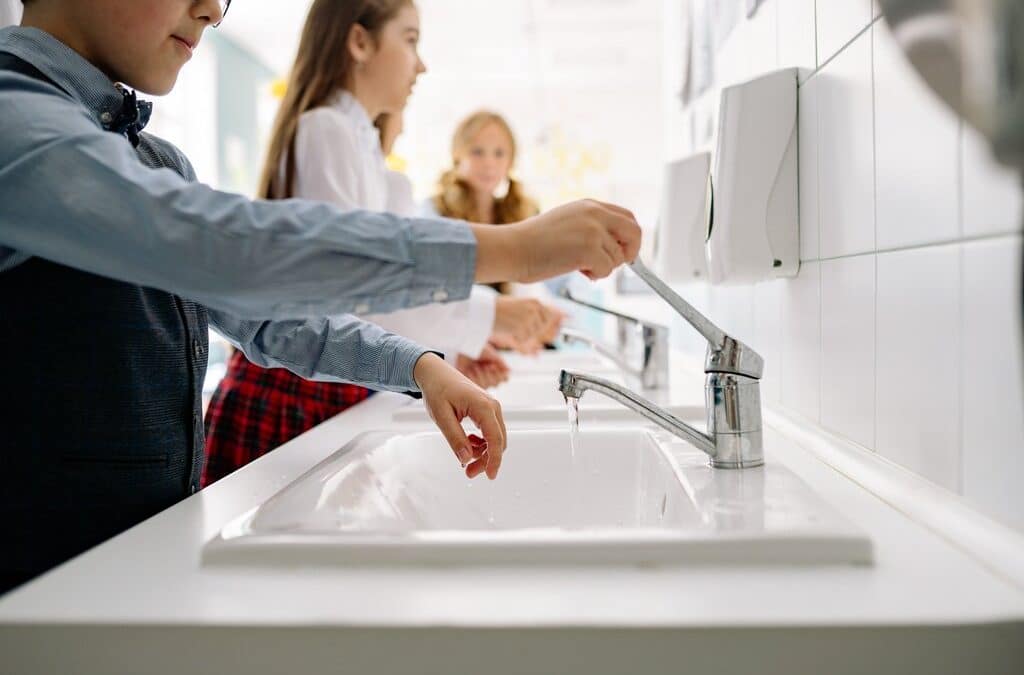If there is one place in any school that needs constant attention, it is the bathroom! In these shared spaces, a school restroom can easily go from clean to a mess within seconds. With the amount of traffic coming and going into these areas, it’s important to know how to clean school restrooms for the safety of your faculty and students. Read on for your complete checklist.
Remember, as we face new viruses during cold and flu season, disinfecting your school’s bathrooms must take priority. A professional cleaning service can help you meet these demands for a higher level of cleanliness To learn more about how 360clean can help your school, contact us today for a free quote.
Know the Difference Between Cleaning and Disinfecting
The New York State Department of Health released an Interim Cleaning and Disinfection Guide that outlines the differences between these two processes. Understanding how these processes differ is essential because each process is necessary when it comes to keeping school bathrooms clean and safe.
Cleaning
The guide above describes cleaning as using a mixture that combines a cleaning detergent with warm water.
Use rags or sponges to wipe down surfaces with the cleaning solution. The purpose of cleaning is to remove soil and debris from surfaces. This process is also effective in eliminating germs before they spread to those who come into contact with surfaces in these areas.
Disinfecting
Disinfecting a surface involves spraying that surface down with a chemical specifically designed to kill viruses and bacterial agents. If you haven’t cleaned the surface first, the disinfectant solution may be less effective.
Once you apply the disinfectant, it must remain on the surface for a predetermined period of time before you can remove it with a clean cloth. Consult the disinfectant manufacturer’s guidelines for the appropriate wait time and to understand other precautions.
Wear Personal Protective Equipment
Cleaning and disinfecting a school bathroom requires exposure to chemical cleaning solutions via touch and inhalation. To avoid the health hazards caused by this type of exposure, make sure to wear latex gloves and a respiration mask. Wear eye protection to guard against accidentally splashing a cleaning or disinfectant agent into your eyes.
If you expose your skin or eyes to a chemical agent, rinse immediately. Seek medical attention as soon as possible.
Clean Surfaces that Are Commonly Touched
Using a cleaning solution and clean rags or sponges, wipe down any surface that students or faculty would commonly touch. These include toilets and urinals.
Discard the rags used to clean those surfaces before using different rags to clean sinks, soap dispensers, and door or stall handles. Wipe down any surface that appears visibly dirty. Empty waste cans. Sweep and mop the floor.
Disinfect Surfaces Throughout the Bathroom
Go through a similar process when disinfecting a bathroom by applying the disinfectant to the same surfaces you previously cleaned. If you use a cleaning agent that also has disinfecting properties, you can clean and disinfect at the same time. Otherwise, this second process is necessary.
Additionally, apply the disinfectant to the walls and windows since students may touch these surfaces as well. When using a disinfecting agent, it’s especially important to follow the instructions provided on the container. Failing to use the disinfectant properly may reduce its effectiveness.
Repeat This Process Regularly
Clean and disinfect each school bathroom on a daily basis—if not more frequently. Since germs can live up to 48 hours and viruses can survive for two to three days, daily cleaning and disinfecting are usually enough. However, if there’s heavier use of a bathroom, you may need to provide a cleaning service two or three times each day.
Each time you service a bathroom, remember to account for the fact that this process requires making a bathroom unavailable for use during cleaning and disinfecting. This may be problematic in areas where you have younger students who are prone to distractions and holding their bladder until the very last second!
Properly Dispose of Waste
The Centers for Disease Control recommend disposing of waste promptly after you finish cleaning and disinfecting any area. This work includes disposing of rags, paper products, gloves, and other used items in a no-touch waste basket.
Empty the wastebasket, but make sure not to touch the inside of the trash bag or any of its contents with your bare hands. After emptying no-touch waste cans, put them back in places where anyone can easily access them. Store your cleaning supplies in a secure area. Finally, wash your hands thoroughly with soap and warm water.
Get Professional Results Every Time
In a process as involved as cleaning school restrooms, sometimes it makes more sense to rely on a thorough cleaning and sanitizing service. To keep these areas safe and healthy for everyone, trust the cleaning experts at 360clean. With our specialized approach to commercial cleaning, you can expect high-quality results every time. To receive a free quote for your school, contact us today to learn more!

